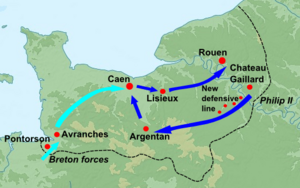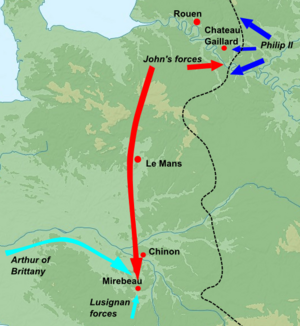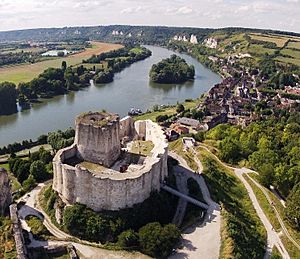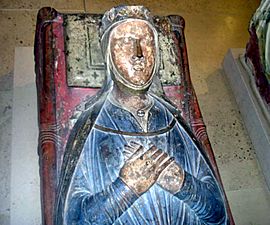Invasion of Normandy by Philip II of France (1202–1204) facts for kids
Quick facts for kids Normandy Campaigns |
|||||||
|---|---|---|---|---|---|---|---|
| Part of Angevin war of succession (1199–1204) | |||||||
 Phillip II's successful invasion of Normandy in 1204 |
|||||||
|
|||||||
| Belligerents | |||||||
|
|||||||
| Commanders and leaders | |||||||
|
|
||||||
| Strength | |||||||
| Mercenary army | |||||||
| Casualties and losses | |||||||
| unknown | unknown | ||||||
The Normandy Campaigns were a series of wars fought in Normandy between 1202 and 1204. During this time, the Kingdom of England battled the Kingdom of France. They also faced rebellions from some of their own nobles. Philip II of France successfully took over the lands in Normandy that belonged to the English king. A key event was the Siege of Château Gaillard. The Normandy Campaigns ended with a French victory, and England lost a lot of its territory in France.
Why the War Started
After Richard the Lionheart died in 1199, two people wanted to become the next ruler of the Angevin lands (which included parts of France and England). One was John, Richard's younger brother. The other was young Arthur of Brittany, Richard's nephew.
Medieval laws were not clear on who should rule. Norman law favored John, while Angevin law favored Arthur. This disagreement quickly led to fighting. Most English and Norman nobles supported John, and he became king in England. His mother, Eleanor of Aquitaine, also supported him. Arthur had the support of nobles from Brittany, Maine, and Anjou. He also had help from Philip II, who wanted to break up the English king's lands in France. With Arthur's army moving towards Angers and Philip's forces moving towards Tours, John's French lands were in danger.
Fighting in Normandy often involved strong castles. These castles, like Château Gaillard, were built at important spots and cost a lot to keep. It was hard for an army to move far without capturing these castles first. This made attacks slow. Armies could be made of feudal soldiers (who served for a short time) or mercenaries (paid soldiers). Mercenaries were more flexible and could fight all year, but they cost much more.
The Treaty of Le Goulet
A peace treaty, called the Treaty of Le Goulet, was signed. But it only lasted for two years. War started again after King John decided to marry Isabella of Angoulême in August 1200. To marry Isabella, John first had to end his marriage to his first wife, Isabel, Countess of Gloucester. He said he had not gotten the Pope's permission to marry her, which was needed because they were cousins.
Historians are not sure why John chose Isabella. Some old writers said he was deeply in love. But marrying Isabella also gave John control of important land between Poitou and Gascony. This helped him control his lands in Aquitaine.
However, Isabella was already engaged to Hugh X of Lusignan. Hugh was an important noble from Poitou. His brother, Raoul, owned lands near the border of Normandy. John's marriage to Isabella threatened the Lusignan family's interests. Their lands were important for moving royal goods and troops across Aquitaine. Instead of trying to make a deal, John treated Hugh badly. This led to the Lusignans rebelling, but John quickly crushed their uprising.
Even though John was the feudal lord over the Lusignans, they could ask John's own feudal lord, King Philip of France, for help. Hugh did this in 1201. Philip then ordered John to come to his court in Paris in 1202. Philip used the Le Goulet treaty to support his demand. John did not want to go because it would make him seem less powerful. He argued that as the Duke of Normandy, he did not have to attend the French court. Philip said he was summoning John as the Count of Poitou, which had no such special rule. When John still refused, Philip declared that John had failed his duties as a vassal. Philip then gave all of John's lands in France (except Normandy) to Arthur. Philip took Normandy for himself and started a new war against John.
The Main Battles

At first, John tried to defend his castles, like he did in 1199. But as the war went on, John's actions became less organized. Philip started to gain ground in the east. In July, John learned that Arthur's forces were threatening his mother, Eleanor, at Mirebeau Castle. John quickly moved his army south to protect her. He surprised Arthur, and all the rebel leaders were captured at the Battle of Mirebeau. With John's southern forces getting stronger, Philip had to pull back in the east and move south to stop John.
John's victory at Mirebeau made his position in France much stronger. But John's actions towards his ally, William de Roches, and his prisoners quickly ruined these gains. John largely ignored William de Roches, a powerful noble, which upset him. John also kept the captured rebel leaders in such bad conditions that twenty-two of them died. At this time, many nobles were related, and treating their family members so poorly was seen as unacceptable. After these events, William de Roches and other allies in Anjou and Brittany left John and joined Philip. Brittany also started a new revolt.
John's money situation was difficult. Philip had more money and resources than John. In 1202–1203, Philip II had an army of 3,307 men on the Norman border. This army included knights, mounted sergeants, crossbowmen, foot soldiers, and mercenaries. This army defended the border and was dismissed after Normandy was conquered.
More of John's allies left him in early 1203. This made it harder for John to move his army around. He tried to get Pope Innocent III to help, but the Pope's messenger was not successful. As things got worse for John, it is believed he may have had Arthur killed. This would remove a rival and weaken the rebellion in Brittany. Arthur was first held at Falaise and then moved to Rouen. After that, Arthur's exact fate is unclear, but many historians believe John was responsible for his death. Rumors of Arthur's death made many people stop supporting John. Arthur's sister, Eleanor, who was also captured at Mirebeau, was kept prisoner by John for many years, though in better conditions.

In late 1203, John tried to help Château Gaillard. This castle was being attacked by Philip, but it still protected the eastern side of Normandy. John tried a complex plan using both land and water forces. Historians today think the idea was clever, but too difficult for the armies of that time to carry out. Philip's forces stopped John's rescue attempt. John then went back to Brittany, hoping to draw Philip away from eastern Normandy. John caused a lot of damage in Brittany, but he did not stop Philip's main attack in eastern Normandy. Historians have different opinions on John's military skills during this campaign. Most recent historians say his performance was okay, but not great.
John's situation quickly got worse. Philip had been strengthening the eastern border of Normandy for years. Also, John's power in the south had been weakened when Richard gave away some important castles years before. John's use of mercenary soldiers in the central areas also made him lose support there. This set the stage for a sudden collapse of English power. John went back to England in December. He ordered a new defensive line to be set up west of Chateau Gaillard. In March 1204, Gaillard fell. John's mother, Eleanor, died the next month. This was a personal loss for John. It also threatened to break up the alliances England had in southern France. Philip moved south around the new defensive line and attacked the heart of Normandy. He faced little resistance. By August, Philip had taken Normandy and moved south to also occupy Anjou and Poitou. John's only remaining land in France was the Duchy of Aquitaine.
Aftermath
The fight for Normandy started again ten years later. In 1214, Pope Innocent III created an alliance of states against France, and John joined it. In the Battle of Bouvines, the allied forces met Philip II's army. The French army won a decisive victory.
After this major defeat, John faced problems in his own kingdom. He was forced to sign the Magna Carta to satisfy the English nobles.


